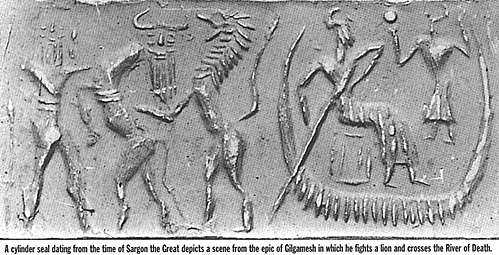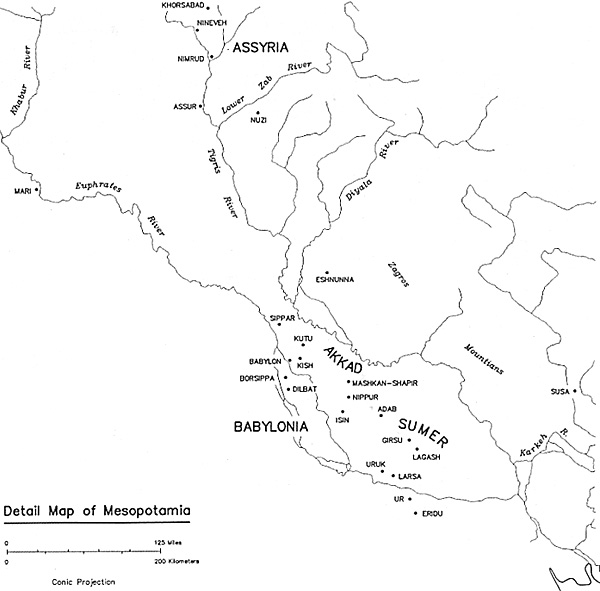 ["Battlefields" specialises in good scenario presentations covering a wide variety of periods. However, most of these assume, on the part of the reader, either knowledge of the period and armies or the time and amenities to study them. As something of a change, David Gundt has provided a fascinating insight into one ancient race, its political history, architecture and military make-up, together with a suggestion for a wargame scenario.]
["Battlefields" specialises in good scenario presentations covering a wide variety of periods. However, most of these assume, on the part of the reader, either knowledge of the period and armies or the time and amenities to study them. As something of a change, David Gundt has provided a fascinating insight into one ancient race, its political history, architecture and military make-up, together with a suggestion for a wargame scenario.]
Admittedly very little is known regarding Sumerian society and culture and even less is known regarding its military system. All of the information that we do have on the Sumerian military comes from archaeological finds such as the Vulture Stele, the National Standard of Ur, and items found in both Royal and common burial sites. However before we get into the Sumerian military it may be useful to discuss a little of the history and background of this culture.
The Sumerians were a non-Semitic race that founded a series of citystates that became collectively known as Sumer. Sumer was located in the lower half of Mesopotamia and in classical times was known as Babylonia. The land to the north of Sumer was known as Akkad. The two regions of Sumer and Akkad were in violent opposition to one another and constantly at war. The border between these two regions was ill defined and constantly shifting mainly because of the results of battle and the rise and fall of rival political elements within both regions. Mesopotamia consisted of the area that is roughly occupied by present day Iraq, from north of the city of Baghdad, down to the Persian Gulf. The first of the city-states to be established was Uruk. The quite famous Gilgamesh was king of Uruk.
Other city-states that were established in Sumer were Lagash, Ur, Nippur, Kish, Eshnunna, Umma, Erech, and Eridu. The climate of this region is extremely hot and dry, and the soil if left to itself, is arid and very unproductive.
The land of Sumer is extremely flat, as it was formed by rivers, and has no minerals and or stone to speak of. This land would seem to be prone to poverty and desolation, but the people that inhabited it; the Sumerians as they came to be known possessed a great intellect and a resolute spirit.
The people of Sumer had an unusual flair for technological invention. Even the very earliest of settlers had figured out the idea of irrigation, which made it possible to channel the silt-laden waters of the Tigris and Euphrates rivers. This enabled the Sumerians to establish very productive fields for agricultural purposes and to also establish rich, lavish gardens in this would be desolate land. Since the land had no minerals or stone to speak of, the Sumerians learned to bake river clay and mud and then fashion them into tools and utensils such as pots, plates, and sickles. Later they learned how to bake this clay and mud in forms or moulds and manufacture bricks for the purpose of building homes, temples, and other structures. Experience taught the Sumerians that buildings made of mud or sundried brick must be elevated on platforms and raised above water level. The earthen rampart was soon discovered to be the best protection against floodwaters. Common sense remarked that a rampart more steeply constructed and higher could also help keep out an enemy, and so the walled city was developed. Such a town quickly became a centre and place of refuge for inhabitants of the outer districts such as farmers and members of small villages that were far too weak to protect themselves. Intellectually the Sumerians were quite advanced. They were levelheaded and clear-sighted and rarely confused fact with fiction.
On the material side they prized possessions such as wealth, full and wellstocked granaries, rich harvests, and stalls filled with cattle. Psychologically they put a great importance on ambition and success as well as prestige, honour, and recognition. The Sumerian was deeply aware of his personal rights, and resented any encroachment on them whether by his King, superior, or his equal. From this evidence it is of absolutely no wonder that the Sumerians were the first to compile laws and law codes, and put everything down into "black and white" in order to avoid any form of misrepresentation and/or arbitrariness.
SUMERIAN GOVERNMENT:
The Sumerians introduced and evolved a system of government. When a town or village was being settled the building of a temple to a particular god from the Sumerian pantheon who was in favour with the settlers as well as being recognised as the patron saint of the community gave a definite religious sanction to the idea of local autonomy. The chief priest or patesi of a temple was believed to be the patron god's principal representative on earth. Since the Sumerians were chiefly a theocratic society, this led to the priest being given the powers and
A cylinder seal dating from the time of Sargon the Great depicts a scene from the epic of Gilgamesh in which he fights a lion and crosses the River of Death. the position of being a civil governor. From the very earliest of dates Mesopotamia had become a land of many small and independent citystates.
Throughout the whole land the Sumerians were the predominant culture, and therefore, to a certain extent, a homogenous population existed. They had imposed everywhere the same basic type of civilisation. The Sumerian language, which was used exclusively in the south of the land, also had its fashionable users in the north.
The laws and customs of the land were uniform as well as the "national religion"; despite the fact of the emphasis that was placed on individual deities that served separate citystates. The next logical step in the evolution of the Sumerian government would be the all too necessary unification of the land. This unification was needed in order to help protect the state from would be outside attack.
However two clear and distinct things hindered this from occurring.
- 1. The never ending quarrelling over land and water. Since the land was a nation of independent city-states, segregation of each community was the quite logical result of this system. Each community would attempt to put as much land as possible under the plough for cultivation, and then cut off any neighbours by vast
reaches of barren marshland. Of course as the marshlands dried up, this not only brought the separate communities within proximity with one another, but also led to competition. Each city-state became blinded with the desire and need for more and more land. As the land became fertile, due mainly to the irrigation of the land through canals, the reclamation of the so called "no-man's land" led to violent conflicts between the city-states. Canals that were dug to water a larger expanse of land would often pass through another city's territory, and this city would simply tap off of this canal for the benefit of their own crops rather than digging their own canal system. Cattle stealing was also very common as it was quicker to steal the cattle you needed rather than breed them yourselves. As we can see the causes of never ending conflict made it necessary for men within the various city-states to band together for protection against enemies all around them.
2. A potent local patriotism, which grew up in the population of the various city-states. The clash of these two factors helps to explain the history of Sumer. The ordinary citizen demanded primarily from his government peace, and respect for the rights of property. Since most of the conflicts between independent citystates were over land, the surest ways to stop these conflicts were to remove or suppress this independence and bring them under the control of one central government.
This gave a ready made opening for the ambitions of local governors, and just because there was so much in common between the peoples of the various city-states the vanquished might surrender without too much difficulty in the domination of a kindred neighbour.
A change in government need not involve oppression and it did help to secure peace. But domination of this sort rested entirely on the use of force, and this power was unstable at best. Let the ruling monarch become weakened by some intrigue at home or from a blow caused by a foreign enemy and there was no loyalty in place to help prop up his authority. Every city had as good a claim to rule as any other city, and if its governors had the ambition for empire, they could usually count on the old sectarian spirit to back and make strong the rebellion. Yet another cause for this loyalty was the fact that most of the ruling monarchs or nobles were often deified. These nobles were often worshipped and at times became the patron saints of these citystates. This coupled along with the aforementioned reasons made the very real prospects of civil war the rule rather than the exception.
Map

The Sumerians
- Historical Background
Civil Wars and the King Lists
Military Organization and Equipment
Wargaming Terrain and Scenarios
Back to Battlefields Issue 10 Table of Contents
Back to Battlefields List of Issues
Back to Master Magazine List
© Copyright 2001 by Partizan Press.
This article appears in MagWeb.com (Magazine Web) on the Internet World Wide Web.
Other articles from military history and related magazines are available at http://www.magweb.com